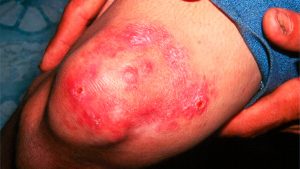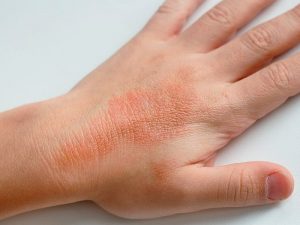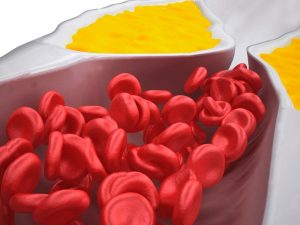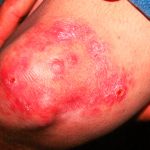Many of us are familiar with chickenpox from our childhood, but what do you know about its sister virus, shingles? Herpes zoster, more commonly known as shingles, is caused by the varicella zoster virus (VZV) – the chickenpox inducing virus. VZV remains dormant in the body and can reactivate later in life to cause shingles. While chickenpox is known as a childhood disease, with 95 per cent of the United States population developing the infection before 18, shingles is associated with aging. In the US, one million people a year get shingles and one in three are aged 60 or above.
The herpes zoster rash can be severely painful to the point of debilitating and can lead to serious complications. There is no cure for shingles and treatments can only shorten the symptoms. If you fall under an at risk group, talk to your doctor about getting a one-time dose of the herpes zoster vaccine.
High–Risk Groups
- People with medical conditions that affect the immune system (cancer, human immunodeficiency virus HIV).
- People over 50.
- Those undergoing cancer treatments such as radiation or chemotherapy.
- People taking immunosuppressive medications (drug transplant medications, steroids).
While anyone who has had chickenpox is at risk of developing shingles, those in at-risk groups should talk to their healthcare professional about the herpes zoster vaccination.
Is Shingles Contagious?
Shingles cannot be passed from one person to another, but active VZV can spread to anyone without chickenpox immunity. The virus transmission occurs through direct contact with fluid from shingles blisters. A person is contagious only during the blister phase, and once the rash crust over the infected person is no longer a risk factor. Shingles is less contagious than chickenpox but infected people should still take steps to avoid transmission:
- Cover your rash.
- Avoid touching or scratching the infected area.
- Wash your hands often to prevent spreading fluid.
- Avoid contact with pregnant women who have never had chickenpox or the vaccine; premature or low-weight infants; people with weak immune systems such as people with HIV or those receiving immunosuppressive medications.
Herpes Zoster Symptoms
Shingles begins as a painful rash that appears on one side of the body or face, then transforms into fluid-filled blisters a few days later. The blisters will typically take seven to 10 days to become scabs. Zoster rashes usually clear up anywhere from two to four weeks. It is vital to see a doctor no later than three days after the rash has begun. Pre-rash symptoms include:
- Pain.
- Itching.
- Tingling in developing rash area.
- Fever.
- Headache.
- Chills.
- Upset s
Most symptoms appear one to five days before the rash.
Shingles Complications
Herpes zoster can lead to severe complications such as:
- Loss of vision: Ophthalmic shingles develop around the eye, which can result in eye infection and even loss of sight.
- Pneumonia.
- Skin infections: Untreated herpes zoster blisters can lead to bacterial skin infections.
- Neurological problems: Shingles rashes can affect certain nerves connected to the brain, causing brain inflammation (encephalitis). The results of encephalitis can include facial paralysis and hearing or balance issues.
- Post-herpetic neuralgia: In some cases shingles pain will continue after the blisters have cleared. This is known as post-herpetic neuralgia and is a result of damaged nerve fibers. Confused damaged fibers will send pain messages from the skin to the brain, causing long-term pain.
In addition to post-herpetic pain, shingles can cause other long-lasting problems such as depression, anxiety, sleeplessness, weight loss, and difficulty with daily activities such as getting dressed, cooking and eating. If you are experiencing any lingering pain or symptoms after normal symptoms have cleared up, talk to your doctor right away.
Shingles Prevention
The only way to prevent shingles is to be vaccinated. A clinical trial consisting of thousands of adults aged 60 and older showed the vaccine reduced the risk of singles by about half. The Centers for Disease Control and Prevention (CDC) recommends that healthy adults 50 years and older and those in high-risk groups receive two doses of the zoster vaccine. The side effects of the zoster vaccine are mild and temporary and include redness, soreness, swelling and itching on the shot site. Most people are safe to receive this vaccine unless they are pregnant, have a weakened immune system or are allergic to specific ingredients in the vaccine.
Shingles vaccines are available at pharmacies and in the doctor’s office. Talk to your healthcare professional to determine if the vaccine is right for you.
Shingles Treatment
Shingles can only be prevented, not cured. If you have been infected with shingles your doctor may prescribe treatments for the severity of the symptoms and length of infection. Treatments for shingles include antiviral medications (to speed the healing process), topical patches, anticonvulsants, tricyclic antidepressants, numbing creams, local anesthetics and analgesics (pain medicine) to relieve the pain from infection. To relieve itching the CDC recommends wet compresses, calamine lotion and colloidal oatmeal baths. In addition to doctor-prescribed treatments, the National Institute on Aging recommends the following tips for at-home shingles relief:
- Get plenty of rest.
- Eat well-balanced meals.
- Try easy exercises such as stretching or walking.
- Apply a cool washcloth to your blisters to ease the pain.
- Perform activities that take your mind off the pain such as watching TV, reading, talking with friends, listening to relaxing music or working on a hobby.
- Avoid stress because it can exacerbate pain symptoms.
- Wear loose-fitting clothing made with natural-fiber.
- Talk to friends and family about your pain levels.
These are treatments in addition to medication. Do not attempt to treat your shingles on your own. If you are experiencing long-lasting pain or the more extreme side effects of shingles, talk to your doctor immediately.











